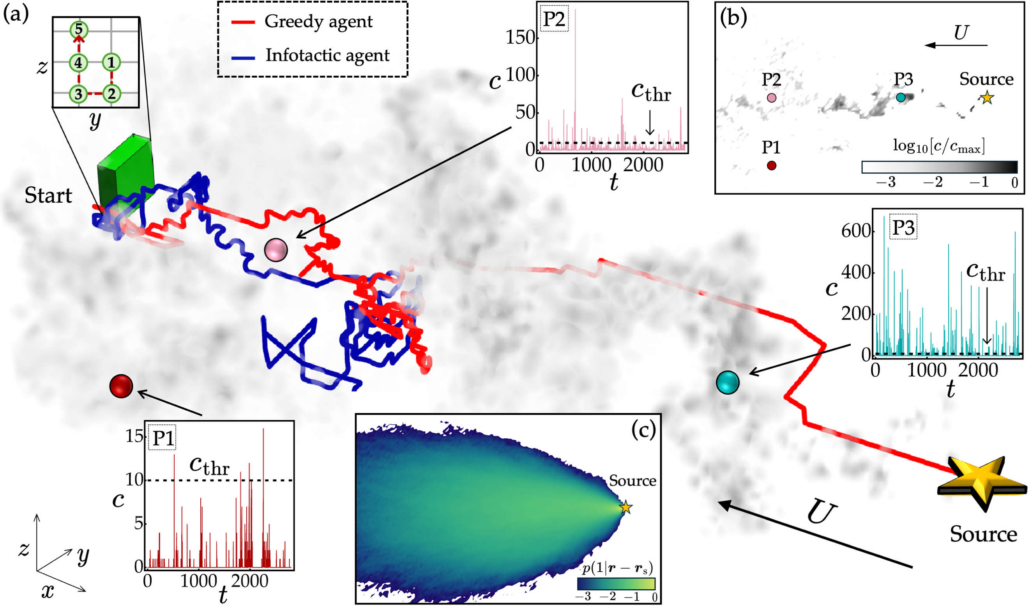CO-SEARCH
Equations informed and data-driven approaches for collective optimal search in complex flows
| Founding Body: | MUR |
|---|---|
| Total grant: | € 190k * |
| Principal Investigator: | Massimo Cencini |
| Other participants: | Department of Physics University of Rome “Tor Vergata” (L. Biferale) |
| Project duration: | 2023-2025 |
| Website: |
Finanziato Dall’unione Europea – Next Generation EU – Piano Nazionale Di Ripresa E Resilienza (PNRR) – Missione 4 “Istruzione E Ricerca” – Componente C2 Investimento 1.1.”Fondo Per Il Programma Nazionale Di Ricerca E Progetti Di Rilevante Interesse Nazionale (PRIN)
* importo finanziamento pari a 189.258,00 €
Partner coinvolti:
CNR-Unit Massimo Cencini (PI, ISC), Alessandra Lanotte (NANOTEC) & Maurizio Carbone
UTOV-Unit Luca Biferale (Resp.), Mauro Sbragaglia, Chiara Calascibetta e Niccolò Cocciaglia; Main external collaborators Lorenzo Piro, Antonio Celani, Robin Heinonen, Fabio Bonaccorso and Massimo Vergassola
Abstract
Locating a source of dangerous/interesting chemical or physical signals transported by a complex turbulent environment is a key, fundamental problem with applications to geophysics, biophysics, robotics and environmental sciences. Multiple methodologies, based on heuristics, information theory, data-driven machine-learning or brute-force, equation-based, numerics have been developed in the last decades. None of them guarantees success. In most applications, partial observability and/or poor knowledge of the environment are additional important bottlenecks. As a matter of fact, the problem of optimally locating (in the shortest time or with minimal failing rate) a localized source in a turbulent flow is an open problem. Only proofs-of-concept exist, mainly based on simplified environmental models, assuming unrealistic full maneuverability or all-to-all communication among the searching agents.
CO-SEARCH aims to make quantitative advancements in two ways. First, we benchmark and validate in realistic complex flows the existing search algorithms, which has never been systematically attempted before. Second, we explore novel collective policies to locate multiple sources and learn about the environmental conditions by inferring the optimal model parameters. Both phenomenological and equation-informed approaches, combined with data-driven methods will be used.
As a glimpse into the problem’s complexity, imagine a single or a group of animals/robots trying to locate a source only relying on the emitted signals conveyed by a turbulent flow. This generates intermittent, highly non-Gaussian, concentration fields with randomly oriented gradients and wide empty regions. Gradient-ascent approaches, such as chemotaxis, are clearly doomed to fail. Two different strategies exist: (i) phenomenological/bio-mimetic, where the agent reacts with hardwired moves; (ii) model-based/cognitive, where some knowledge of the environment allows the agent to update its belief on the source location and decide how to move accordingly. Infotaxis, performing a gradient ascent in information, is one of the most promising recent solutions. Still, its efficiency in complex flows is largely unknown. Even less is known whether collective search offers better performances, with affordable computational costs, already for simplified set-ups. Cognitive strategies can become inefficient due to model errors, unavoidable in realistic environments. Whether multi-agents policies can mitigate such epistemic limitation by the many wrongs principle or by on-the-fly model refinement is unexplored as of now.
Furthermore, CO-SEARCH aims at leaving a long-term legacy of its scientific advancements by creating an open-database for single and multiple emitting sources in complex flows. The decades-long collaboration of the groups at CNR and Tor Vergata University, together with a well established international network, ensure the highest chance of success.
Setup for collective olfactory search with policy heterogeneity: (a) Snapshot of the concentration of odor particles (logarithmic grayscale) emitted by the source (yellow star), obtained by the direct numerical simulations of a turbulent flow. The blue (red) curves correspond to the typical trajectories of an infotactic (greedy) agent starting from the region indicated by the green box and cooperating to find the source. Agents are initially placed close to each other, as depicted in the top-left inset. Three plots (P1-P3) display the intermittent time evolution of the odor signal at the point indicated by the arrow. Agents can detect odor particles when their number is above a given treshold. Search starts when at least one agent detects an odor signal. U denotes the mean wind. (b) Two-dimensional snapshot of the concentration of odor particles within a thin slab parallel to the mean wind U containing the source. Points P1, P2, and P3 are also reported here using the same color scheme as in the rest of the figure. (c) Two-dimensional cut of the probability map of making a detection in the plane parallel to the mean wind U and containing the source. This map, constituting the environment model the agents use to interpret their observations (empirical likelihood), is obtained by coarse-graining all the odors’ trajectories, thresholding on the number of detectable particles, and finally averaging over time. From Ref.[1].
Publications within the project
[1] L. Piro, R. A. Heinonen, M. Carbone, L. Biferale, and M. Cencini. “Policy heterogeneity improves collective olfactory search in 3-D turbulence.” arXiv preprint arXiv:2504.11291 (2025).
[2] R. A. Heinonen, L. Biferale, A. Celani and M. Vergassola “Exploring Bayesian olfactory search in realistic turbulent flows ” arXiv preprint arXiv:2502.21258 (2025).
[3] L. Balocchi, L. Piro, L. Biferale, S. Bonafoni, M. Cencini, I. Nannipieri, A. Ria, and L. Roselli. “Enhanced Gas Source Localization Using Distributed IoT Sensors and Bayesian Inference.”, Physics of Fluids 37, 065127 (2025) arXiv preprint arXiv:2411.13268 (2024).
[4] L. Piro, R. A. Heinonen, M. Cencini, and L. Biferale. “Many wrong models approach to localise an odour source in turbulence with static sensors.” Journal of Turbulence (2025): 1-21. [arXiv: 2407.08343]
[5] R.A. Heinonen, L. Biferale, A. Celani, and M. Vergassola. “Optimal trajectories for Bayesian olfactory search in turbulent flows: The low information limit and beyond.” Physical Review Fluids 10, 044601 (2025). [arXiv:2409.11343]
Open access databases
Point source emitting in 3D turbulent flows: “TURB-Smoke Smart-TURB”
Description and Validation: L. Biferale, F. Bonaccorso, N. Cocciaglia, R. A. Heinonen, and L. Piro. “TURB-Smoke. A database of Lagrangian pollutants emitted from point-sources and dispersed in turbulent flows.” arXiv preprint arXiv:2507.22749 (2025)


